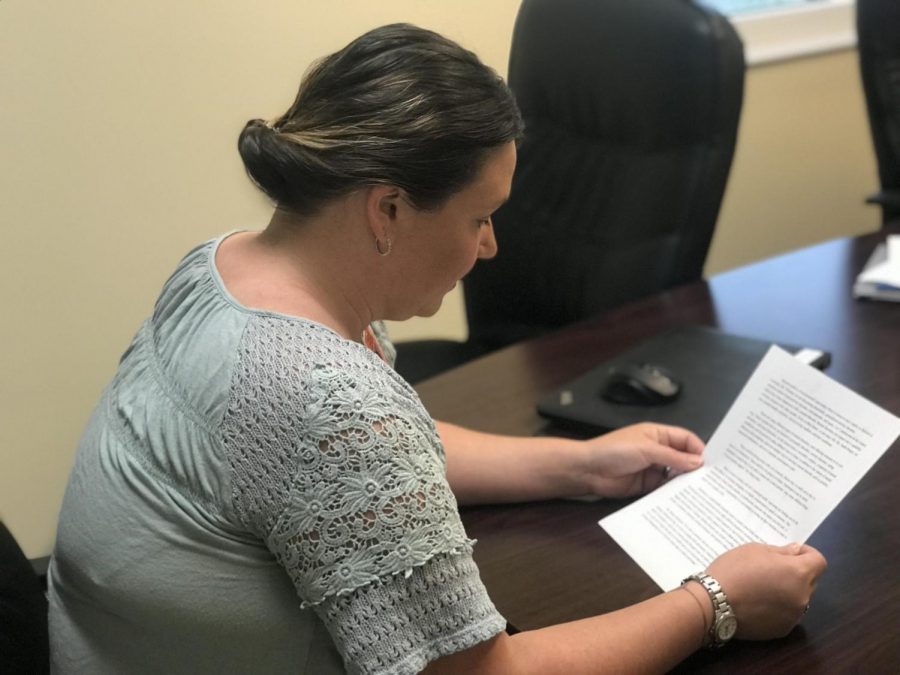Receiving Mental Health Counseling
Introducing Our New Counselor And Discussing Important Topics Related To Mental Health
Ms. Sarah Berger, counselor, reading a document related to mental health.
November 19, 2019
Mental health has a monumental importance when it comes to the ability to function in everyday life. Whether we are discussing depression, generalized anxiety disorder, attention-deficit hyperactivity disorder, or even schizophrenia 1 in 5 adolescents in the United States have been diagnosed with a mental disorder. Mental disorders can impact one’s capability to learn, interact with other people, focus on their future, or just enjoy life. Ms. Sarah Berger, our new mental health counselor, strives to help students with their conditions.
There are many different types of mental disorders, each affecting someone in its own way. These include but are not limited to personality disorders, anxiety disorders, eating disorders, and mood disorders. The human brain is incredibly complex, symptoms of mental conditions can be present in many different ways or forms. In addition to the variety of mental illnesses and symptoms, there are multiple ways to develop a mental disorder, such as genetics, chemical imbalances, and or a traumatic environment or past.
“They could be having issues with a lot of anxiety. Maybe they’re really sad or they’ve hurt or cut themselves. There could be a lot going on at home. Sometimes it can be family situations or maybe they’re not able to remain safe in their parents’ care, many different things. I’m just another support,” Berger, states.
Speaking to a mental health counselor inside or outside school holds many benefits. Counselors provide professional advice and a different perspective on prominent or even hidden issues, giving patients a chance to express themselves without judgment or fear of feeling invalid. An additional, professional perspective allows patients to learn in-depth about possible traumas, triggers, and solutions. In therapy, finding solutions may include recording your emotions in a journal or worksheet, practicing calming techniques, and cognitive behavioral therapy.
Berger explained, “If we have somebody who has a lot of anxiety and a tough time making it through the day, we work on coping skills and anxiety reduction so people function better. If somebody is really sad, or maybe going through a loss, we work on our feelings. If we’ve got a lot of anger that gets us in trouble and we get kicked out of school, we would focus on anger management so we can have better days at school and home.”
However, asking for help is at many times, not as straightforward or simple as it may seem. For many with mental conditions, attempting to become content with life through opening up can be extremely troublesome as a result of intense stigma present within our society. Stigma is a term often used to represent shame associated with having a mental illness. This shame is frequently brought up by harsh judgment from others.
According to the Mayo Clinic, “Stigma is when someone views you in a negative way because you have a distinguishing characteristic or personal trait that’s thought to be, or actually is, a disadvantage. Unfortunately, negative attitudes and beliefs towards people who have a mental health condition are common.”
One example of stigma is mocking someone for receiving psychological help. Psychological help includes seeing a therapist or taking medication. Stigma also involves fear of others with a mental illness, resulting in those with a condition feeling out of place. The effects of stigma are harmful, causing one to isolate themselves from others out of a fear of being judged. According to Vanessa Mejias, a psychologist, stigma is both understandable and damaging.
“I understand what stigma comes from because not being able to see where there’s a problem is a scary thing. Mental health is invisible and it’s scary; it can take somebody’s life. It also comes from generations of keeping your family business within the family. If somebody has depression, ADD, anxiety, or anything like that, many people don’t say anything. They don’t want anybody to know,” Mejias explained.
Despite stigma being frightening to many, receiving help is crucial to managing the massive amounts of pressure mental conditions possess. In order to receive help, a student can first talk to their parents or a guidance counselor. Guidance counselors are always here for support. From there, counseling can be requested, scheduled, and provided.
“I’m not a school employee, so that means I have to get the referral, and I have the parents come in and sign a release. After, the parents meet with me and do the intake before I can meet with the kids. If there was a crisis, like the loss of a student, I could come in and do some coping skills with the class” Berger, said.
Despite counselors providing plenty of support, care, and advice, it is up to the patient to take care of themselves while not in sessions. An important practice to involve yourself in is self care. Even though the practice of self care is commonly spoken about, it is easy to fall into the trap of not taking care of yourself. Self care includes eating regularly and healthily, sleeping seven to nine hours nightly, and limiting naps to an hour or less. A lack of self care amplifies one’s feelings negatively. Combining opening up with self care is essential to improving one’s happiness. Despite the lengthy journey of mental health being filled with obstacles, it’s important for those with a mental illness to overcome these obstacles in the best, most positive way they can.
A senior who will be referred to as source one states, “Treating a physical illness is not nearly as stigmatized as treating a mental illness. Some people need help with physical conditions, while others need help with mental conditions.Based on my experience, people who judge you for having a mental illness just don’t fully understand what a mental condition is, or how common they are. It’s comforting that help is offered at our school.”



